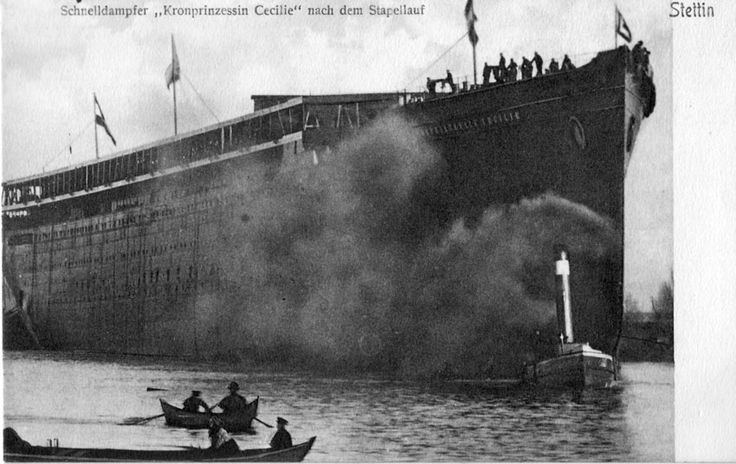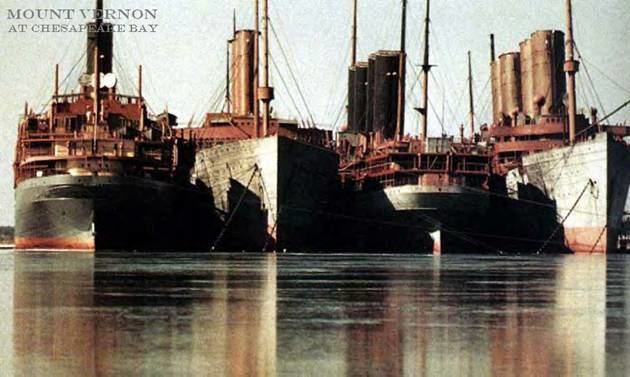Namesake Crown Princess Cecilie Launched 1 December 1906 Beam 22 m | Owner North German Lloyd Route Transatlantic Length 209 m | |
 | ||
Name SS Kronprinzessin Cecilie Builder AG Vulcan, Stettin, Germany | ||
SS Kronprinzessin Cecilie was an ocean liner built in Stettin, Germany in 1906 for North German Lloyd that had the largest steam reciprocating machinery ever fitted to a ship. The last of four ships of the Kaiser class, she was also the last German ship to have been built with four funnels. She was engaged in transatlantic service between her homeport of Bremen and New York until the outbreak of World War I.
Contents

On 4 August 1914, at sea after departing New York, she turned around and put into Bar Harbor, Maine, where she later was interned by the neutral United States. After that country entered the war in April 1917, the ship was seized and turned over to the United States Navy, and renamed USS Mount Vernon (ID-4508). While serving as a troop transport, Mount Vernon was torpedoed in September 1918. Though damaged, she was able to make port for repairs and returned to service. In October 1919 Mount Vernon was turned over for operation by the Army Transport Service in its Pacific fleet based at Fort Mason in San Francisco. USAT Mount Vernon was sent to Vladivostok, Russia to transport elements of the Czechoslovak Legion to Trieste, Italy and German prisoners of war to Hamburg, Germany. On return from that voyage, lasting from March through July 1920, the ship was turned over to the United States Shipping Board and laid up at Solomons Island, Maryland until September 1940 when she was scrapped at Boston, Massachusetts.
Concept

Kronprinzessin Cecilie, built at Stettin, Germany, in 1906 by AG Vulcan Stettin, was the last of a set of four liners built for North German Lloyd, and the last German liner to carry four smokestacks. She was the product of ensuing competition between Germany and the United Kingdom for supremacy in the North Atlantic. Her older sister, Kaiser Wilhelm der Grosse had been introduced in 1897 and was a great success. Her popularity prompted North German Lloyd to build three more superliners, namely Kronprinz Wilhelm (1901), Kaiser Wilhelm II (1903) and finally Kronprinzessin Cecilie.

In 1907 Wiegard trusted Eduard Scotland and Alfred Runge with the interior design of the ship. They designed luxury cabins where the beds would convert to sofas and the washstands would convert into tables. All of the metalwork was gilded; the surfaces were generally white while the wooden surfaces of violet amaranth were inlaid with agate, ivory and citron wood.

As designed the ship had 287 first class, 109 second class cabins and 7 compartments for steerage passengers. Passenger capacity was 775 first class, 343 second class and 770 steerage passengers for a total of 1,888 supported by a crew of 679 that included 229 stewards and stewardesses and 42 cooks, pantrymen, barbers, hairdressers and other passenger service people. Two "Imperial suites" had a parlor, private dining room, bedroom and bath room with toilet while eight other suites had all but the dining room. Twelve deluxe rooms had a large bedroom with bathroom and toilet.

The liner was 19,400 GT and was 215.29 metres (706 ft 4 in) length overall, 208.89 metres (685 ft 4 in) length between perpendiculars, by 22.00 metres (72 ft 2 in) abeam. She had two reciprocating, quadruple-expansion steam engines that powered two screw propellers. Kronprinzessin Cecilie sailed at a comfortable 23 knots (43 km/h; 26 mph).
German career
Named after Crown Princess Cecilie of Prussia, she was launched by her father in law Wilhelm II, German Emperor. In July 1907, the new Kronprinzessin Cecilie was planned to leave Bremerhaven on her maiden voyage. However, before the voyage could take place, the ship sank in Bremerhaven harbour. It was not until the next month on 6 August, had the ship been pumped out and repaired, before finally setting out.
In comparison with a $2,500 first class suite ticket, the immigrant could sail on Kronprinzessin Cecilie for a mere $25 – one hundred times cheaper.
The interiors of the "four flyers", as they were called, were special. The entire ship was fitted with the best of craftsmanship Germany could offer; the salons were full of ornamented wood and gilded mirrors. While her sister, SS Kaiser Wilhelm II was thought by some to be too extravagant, Kronprinzessin Cecilie was a popular ship. Some of her first class suites were fitted with dining rooms so the passengers who booked the suite could dine in private if they did not wish to take their meals in the main restaurant. Also, a fish tank was placed in the kitchen, providing first class passengers with the freshest of fish.
The liner operated on North German Lloyd's transatlantic route travelling from Bremen, with occasional calls at other ports, including Boston and New Orleans. The ship was steaming toward Germany from America with Captain Charles Polack, who had succeeded Dietrich Hogemann in 1913, when she received word of the outbreak of war. In addition to 1,216 passengers, including some British reservist, she was carrying $10,679,000 in gold and $3,000,000 in silver. The ship, bound for Bremen, was nearing Liverpool when directed to head back to the closest port in the neutral United States to avoid capture by the British Navy and French cruisers. Captain Polack had her normally all-buff funnels painted with black tops so as to resemble the liner Olympic or another ship of the British White Star Line as a form of disguise.
Due to the liner's dwindling fuel Bar Harbor, Maine, though not a large port, was selected with the ship being brought in 4 August 1914 piloted by a local banker and yachtsman as none of the ship's officers were familiar with the port. North German Lloyd representatives met in Washington with officials of the Departments of State, Treasury, Commerce and the United States Revenue Cutter Service (USRCS) with the result USRCS Androscoggin was ordered to Bar Harbor to prevent unauthorized departure of foreign vessels but primarily to protect the transfer of gold and silver, as well as all mail and passengers, from Kronprinzessin Cecilie to shore to be transported by train to New York. Androscoggin, joined by the destroyer USS Warrington, arrived at Bar Harbor on 6 August with wild speculation in the press. On 7 November the ship moved to Boston where she was to remain while civil suits against the ship were resolved in federal court.
Navy
Kronprinzessin Cecilie was commandeered by the United States on 3 February 1917 and transferred from the United States Shipping Board (USSB) to the U.S. Navy when America entered the war that April. She was commissioned 28 July 1917 and renamed USS Mount Vernon after George Washington's Virginia home. She was fitted out at Boston to carry troops and materiel to Europe.
Mount Vernon departed New York for Brest on 31 October 1917 for her first U.S. Navy crossing, and during the war made nine successful voyages carrying American troops to fight in Europe. However, early on the morning of 5 September 1918, as the transport steamed homeward in convoy some 200 nautical miles (370 km) from the French coast, her No. 1 gun crew spotted a periscope some 500 yards (460 m) off her starboard bow. Mount Vernon immediately fired one round at German U-boat U-82. The U‑boat simultaneously submerged, but managed to launch a torpedo at the transport. Mount Vernon's officer of the deck promptly ordered right full rudder, but the ship could not turn in time to avoid the missile, which struck her amidships, knocking out half of her boilers, flooding the midsection, and killing 36 sailors and injuring 13. Mount Vernon's guns kept firing ahead of the U‑boat’s wake and her crew launched a pattern of depth charges. Damage-control teams worked to save the ship, and their efforts paid off when the transport was able to return to Brest under her own power. Repaired temporarily at Brest, she proceeded to Boston for complete repairs.
Mount Vernon rejoined the Cruiser and Transport Service in February 1919 and sailed on George Washington’s birthday for France to begin returning veterans to the United States. Mount Vernon pulled out of port on 3 March 1919 at 11 PM to return to the United States. Some of her notable passengers during her naval service were: Admiral William S. Benson, Chief of Naval Operations; General Tasker H. Bliss, Chief of Staff of the United States Army; Col. Edward M. House, Special Adviser to President Wilson; and Newton D. Baker, Secretary of War.
Army
On 17 October 1919 Mount Vernon was transferred to the War Department for operation by the Army Transport Service where the ship was assigned to the Army's Pacific fleet based at Fort Mason in San Francisco. USAT Mount Vernon made one trip between March and July 1920 to Vladivostok, Russia embarking elements of the Czechoslovak Legion to be disembarked at Trieste, Italy and 300 German prisoners of war for Hamburg, Germany. On return the ship was turned over to the United States Shipping Board and laid up at Solomons Island, Maryland.
Scrapping
At the outbreak of World War II in 1939, the Americans offered the former Kronprinzessin Cecilie to the British as a troop transport, who refused on the pretext that she was too old. The ship was scrapped in Boston, Massachusetts on 13 September 1940.
